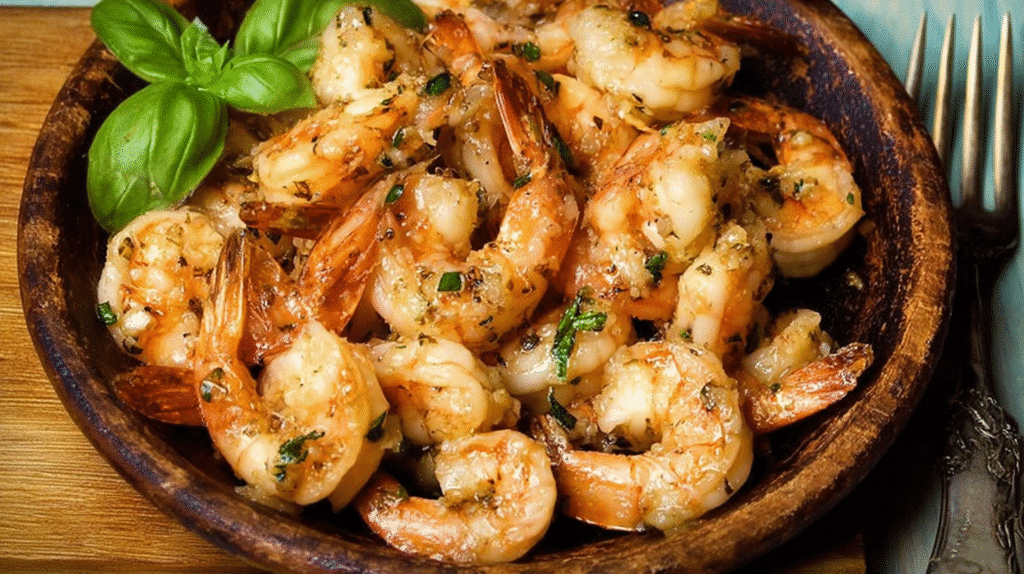
Why Sous Vide Shrimp is a Game Changer
Growing up near the Gulf Coast, Sunday dinners often featured a pile of shrimp tossed in a cast iron skillet. But no matter how closely we watched the pan, some shrimp would end up rubbery while others stayed undercooked. That changed when I discovered sous vide.
This sous vide shrimp recipe completely eliminates the guesswork. It locks in flavor and creates a consistently tender, juicy texture that stovetop or boiled shrimp just can’t match. If you’ve ever had shrimp go from sweet to spongey in a second, you’ll understand why this method feels like unlocking a secret.
Here at Recent Recipe, our journey started with the belief that great food doesn’t have to be complicated. We celebrate reliable methods that bring joy back into your kitchen, and this sous vide shrimp recipe captures that spirit beautifully. Whether you’re prepping for a family meal or impressing dinner guests, this is the kind of recipe that quietly becomes your go-to.
The beauty of sous vide lies in precision. By cooking the shrimp at an exact temperature, you eliminate the stress of overcooking. It’s a set-it-and-forget-it approach, but with restaurant-level results. You’ll notice the difference in the first bite—firm but tender, juicy without being watery, and infused with flavor all the way through.
So if you’ve been frustrated by rubbery or mushy shrimp, this sous vide shrimp recipe is your solution. No more overcooked shells. No more dry centers. Just beautifully cooked shrimp every time.
What is Sous Vide? (And Why It Works for Shrimp)
Sous vide (pronounced soo veed) is a French technique that translates to “under vacuum.” It involves sealing food in a bag and placing it in a water bath held at a precise temperature. Unlike traditional cooking where heat spikes and fluctuates, sous vide gently warms food to your desired doneness and holds it there—without ever going over.
This method is especially effective for shrimp. Because shrimp are so small and lean, they can become overcooked in a flash. High heat causes the muscle fibers to contract tightly, making shrimp tough and dry. With sous vide, you’re using low and stable heat, so the texture remains plump, silky, and flavorful.
Most people make the mistake of boiling shrimp rapidly or grilling them until the color looks right—but that often leads to disappointment. Sous vide cooking is all about precise control over time and temperature. It’s cooking with intention, not guesswork.
What makes this sous vide shrimp recipe even more reliable is how it eliminates the biggest shrimp pitfalls:
- Rubbery shrimp? That happens when temps are too high—over 140°F.
- Mushy shrimp? That’s often from head-on shrimp with enzymes still active, or from cooking too long.
- Uneven doneness? Completely avoided in the sous vide bath.
Whether you’re using fresh or frozen shrimp (yes, you can sous vide straight from frozen), this method works every single time. The gentle cooking ensures your shrimp stay juicy and snap-tender—never chalky or stringy.
By starting your journey with this technique, you’re not just learning a recipe. You’re mastering a method. This sous vide shrimp recipe is more than just a set of instructions—it’s your ticket to better shrimp, every single time.
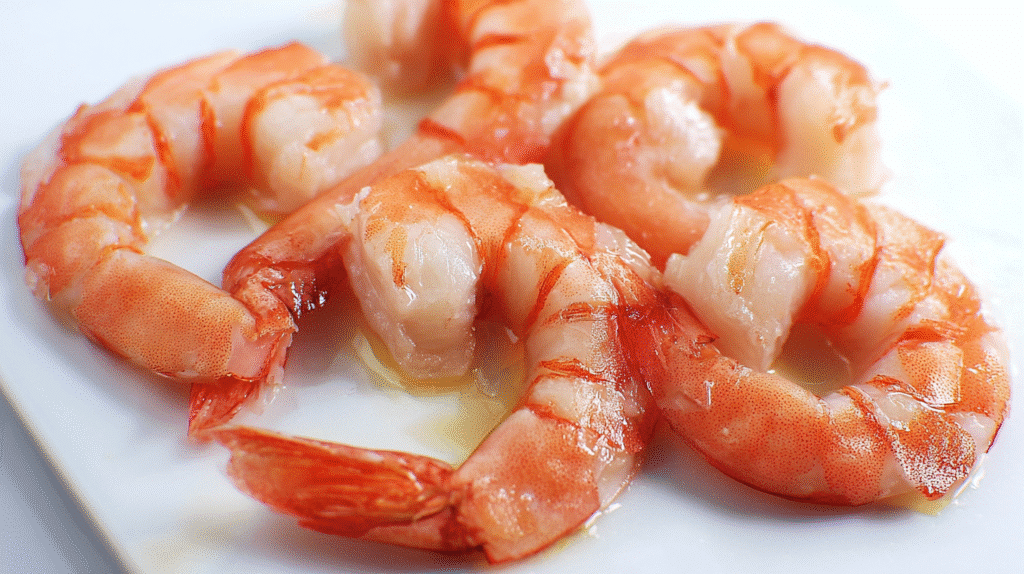
Ingredients & Tools You Need
To master the perfect sous vide shrimp recipe, start with quality ingredients and reliable tools. The best part? You don’t need anything fancy. Here’s what you’ll need to make flavorful, juicy shrimp at home—whether you’re cooking fresh or frozen.
Print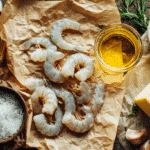
Sous Vide Shrimp Recipe (Perfectly Juicy Every Time)
- Total Time: 40 mins
- Yield: 4 servings 1x
Description
Sous vide shrimp recipe that delivers juicy, tender results every time. Includes frozen option, garlic butter variation, and pro searing tips.
Ingredients
1 lb large shrimp, peeled and deveined
1/2 tsp kosher salt
1/2 tsp baking soda
2 tbsp olive oil or butter
2–3 garlic cloves, sliced
Optional: lemon slices, fresh herbs, chili flakes
Instructions
1. Preheat water bath to 130°F (54.4°C)
2. Toss shrimp with salt and baking soda, rest 15 minutes
3. Place shrimp, garlic, butter/oil and seasonings in bag
4. Seal using vacuum or water displacement method
5. Cook for 30 minutes (fresh) or 45–50 minutes (frozen)
6. Remove and pat shrimp dry with paper towels
7. Sear in hot pan 30–45 seconds per side
8. Serve immediately with desired sides
Notes
Always sear after sous vide for enhanced flavor and texture.
Use IQF headless shrimp to avoid mushiness.
130°F offers ideal tender texture; 135°F for firmer bite.
Try variations like garlic butter, lemon dill, or Cajun.
- Prep Time: 10 mins
- Cook Time: 30 mins
- Category: Dinner
- Method: Sous Vide
- Cuisine: American
Nutrition
- Serving Size: 1/4 lb
- Calories: 180
- Sugar: 0g
- Sodium: 720mg
- Fat: 10g
- Saturated Fat: 4g
- Unsaturated Fat: 5g
- Trans Fat: 0g
- Carbohydrates: 1g
- Fiber: 0g
- Protein: 21g
- Cholesterol: 145mg
Keywords: sous vide shrimp recipe, sous vide garlic shrimp recipe, shrimp sous vide recipe, sous vide frozen shrimp
Main Ingredients:
- 1 lb of large, cleaned shrimp (16–20 count, shells removed and deveined)
- ½ tsp kosher salt
- ½ tsp baking soda (helps firm texture)
- 2 tbsp olive oil or unsalted butter
- 2–3 garlic cloves, smashed or sliced
- Optional flavorings: lemon slices, fresh thyme, red pepper flakes, dill, or smoked paprika
Optional Add-Ins for Variations:
- Lemon zest & fresh dill
- Cajun spice mix
- Chili flakes & lime juice
- Fresh parsley & lemon-garlic butter
- Coconut milk & curry powder
Essential Tools:
- Sous vide immersion circulator (Anova, Joule, or similar)
- Large pot or heat-proof container for the water bath
- Ziplock freezer bags or vacuum seal bags
- Tongs
- Cast iron or stainless-steel pan (for finishing sear)
- Paper towels (to pat dry before searing)
Tip: You don’t need a vacuum sealer! Use the water displacement method with a ziplock bag: place the shrimp in the bag, seal almost all the way, then slowly lower into water so pressure pushes air out—then seal fully.
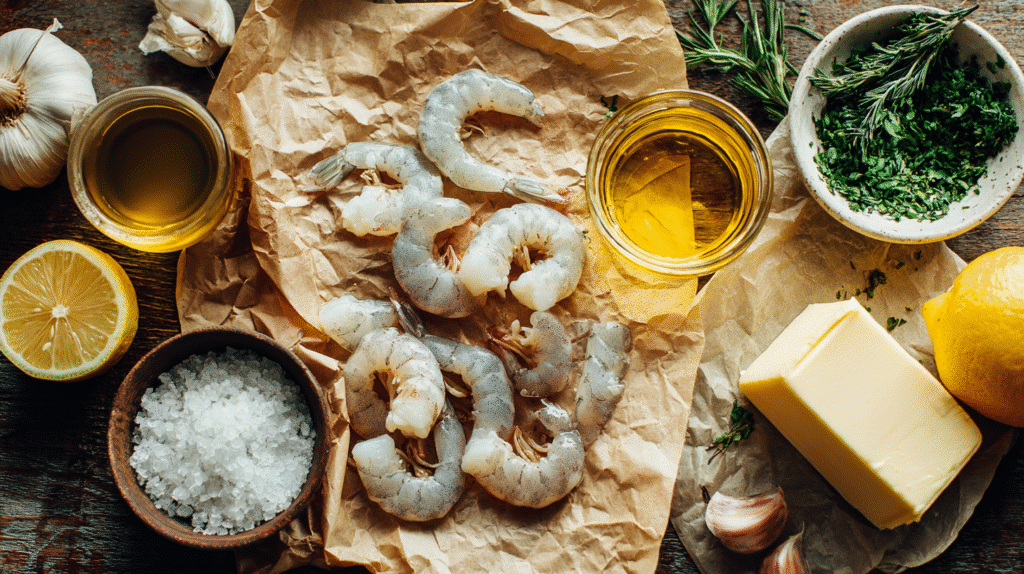
Step-by-Step Cooking Instructions (From Fresh or Frozen)
This is your foundational sous vide shrimp recipe, easily adaptable for fresh or frozen shrimp.
Cooking sous vide is about precision—not speed—and the reward is perfectly tender, never rubbery shrimp.
For Fresh Shrimp:
- Preheat water bath to 130°F (54.4°C) for tender and juicy texture.
(You can go up to 135°F for firmer bite or 140°F for snappier texture.) - Prep the shrimp:
Pat shrimp dry. Combine shrimp with salt and baking soda in a bowl. Let rest for 15–20 minutes. This step firms up the texture and adds a natural brininess. - Bag it up:
Add the shrimp, olive oil or butter, garlic, and any extra seasonings to a ziplock or vacuum-seal bag. Use the water displacement method or vacuum sealer. - Sous vide cook:
Submerge in preheated water bath for 30 minutes. Ensure the bag is fully under water. - Remove & pat dry:
After 30 minutes, remove the bag and transfer shrimp to a plate lined with paper towels. Dry thoroughly—this is crucial for a good sear. - Finishing sear (non-negotiable):
Warm a skillet over medium-high heat and add a small amount of oil or butter. Quickly sear shrimp for 30–45 seconds per side until lightly golden. This step brings flavor and caramelization via the Maillard reaction. - Serve right away with your favorite sides (see suggestions in Part 4).
For Frozen Shrimp (No Thawing Required):
- Preheat water bath to your desired temp (130°F recommended).
- Season the frozen shrimp: You can lightly salt and add baking soda beforehand, or toss quickly before sealing.
- Bag and seal: Use a vacuum bag or water displacement method. Add butter/oil and aromatics like garlic or lemon.
- Cook sous vide for 45–50 minutes.
(Add 15–20 minutes to standard cook time when starting from frozen.) - Pat dry, sear, and serve as above.
Pro Tips:
- Shrimp turn pink and opaque when done—this is normal.
- Texture is everything. For firm but not rubbery shrimp, 130–135°F is your zone.
- Use shell-on for more flavor, but be sure to peel before searing.
You now have the core shrimp sous vide recipe locked in. Whether fresh or frozen, seared or simply served, you’ll never go back to boiled or steamed again.
The Ultimate Shrimp Sous Vide Time & Temp Chart
Shrimp texture can change dramatically with just a few degrees of heat. That’s why sous vide is so powerful—it lets you dial in the exact texture you want. Use this quick reference guide to tailor your sous vide shrimp recipe to your preferences.
| Temperature (°F) | Cook Time (Fresh Shrimp) | Texture Description |
|---|---|---|
| 125°F | 30 minutes | Very tender and silky |
| 130°F | 30 minutes | Juicy, tender, slightly firm |
| 135°F | 30 minutes | Firm and snappy, restaurant-style |
| 140°F | 30 minutes | Very firm, bordering on rubbery |
Note: Add 15–20 minutes if cooking sous vide frozen shrimp. Keep the same temperature range for best results.
If you’re unsure, 130°F is the safest starting point. It delivers the perfect balance between soft and structured—a great base for variations like sous vide garlic shrimp recipe or lemon herb shrimp.
Avoiding Common Mistakes (Rubbery? Mushy? Here’s Why)
A major advantage of the sous vide method is that it eliminates overcooking. Still, issues like mushy or rubbery shrimp can happen—especially if you’re using the wrong type of shrimp or temperature. Here’s how to fix that.
Problem: Mushy Shrimp
- Cause: Enzymes from head-on shrimp (especially proteases) can break down muscle fibers.
- Solution: Buy headless, IQF (individually quick frozen) shrimp. Also, avoid soaking shrimp in acidic marinades before sous vide—they accelerate breakdown.
Problem: Rubbery Texture
- Cause: Cooking above 140°F tightens muscle fibers too much.
- Solution: Stay in the 130–135°F range. This keeps the bite firm but pleasant.
Problem: Watery or Bland Flavor
- Cause: Overcrowding the bag, under-seasoning, or skipping the sear.
- Solution: Don’t overload shrimp. Use fat (butter or oil) and aromatics in the bag. Always finish with a hot sear to intensify taste and improve mouthfeel.
Extra Tip: Shrimp should turn from translucent gray-blue to a consistent pink and white color. That’s the natural doneness indicator—use it with confidence even if you’re new to sous vide cooking.
Using this knowledge, you can confidently avoid the pitfalls that plague traditional shrimp recipes. Whether it’s your first time or your fiftieth, this sous vide shrimp recipe will keep delivering juicy, satisfying results.
Flavor Variations to Try Tonight
Once you’ve nailed the basic sous vide shrimp recipe, it’s easy to switch up the flavor profile. These variations use the same cooking method—just change up the aromatics or seasonings in your bag before the cook. Whether you like bold, citrusy, or herbaceous shrimp, there’s a style for you.
1. Garlic Butter Shrimp (Classic Favorite)
Use butter instead of oil, 3–4 smashed garlic cloves, and a pinch of salt. Finish with chopped parsley and lemon juice. This builds on the sous vide garlic shrimp recipe trend that’s both restaurant-worthy and easy for weeknights.
2. Lemon & Dill
Add 2–3 lemon slices, fresh dill, and a dash of black pepper to your bag. After cooking, drizzle with olive oil and serve over quinoa or greens.
3. Cajun Spice Shrimp
Toss shrimp with Cajun seasoning before sealing. Great served with rice, grits, or in tacos with slaw.
4. Chili-Lime Zing
Add chili flakes or a slice of fresh jalapeño with a few sprigs of cilantro and lime zest. It pairs well with mango salsa and corn tortillas.
5. Coconut Curry Shrimp
Add ¼ cup coconut milk, curry powder, and a few basil leaves. After sous vide, reduce bag liquid to a sauce and serve with rice noodles.
All variations follow the same core method:
130°F for 30 minutes (fresh) or 45–50 minutes (frozen). Pat dry, sear in a hot pan with oil or butter for 30–45 seconds per side, and serve.
Looking for more creative recipes? You can pair this dish with options from our dinner section or turn it into a protein topper for a light lunch salad.
Frozen Shrimp & Troubleshooting Guide
Yes—you can absolutely make this sous vide shrimp recipe from frozen shrimp. And no, you don’t need to thaw them first. Here’s how to do it right.
How to Sous Vide Frozen Shrimp:
- Do not thaw. Place frozen shrimp straight into the bag.
- Add fat + aromatics: Butter, oil, garlic, lemon slices—just like fresh.
- Seal tightly using water displacement or vacuum seal method.
- Cook at 130°F–135°F for 45–50 minutes.
- Dry well and sear. Frozen shrimp can release more moisture. Dry thoroughly for the best sear.
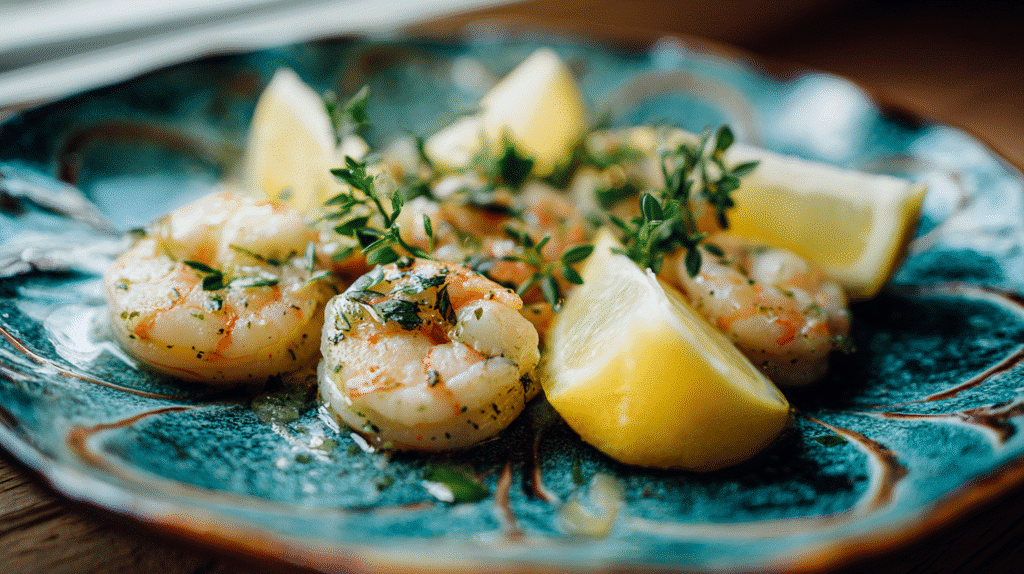
Common Frozen Shrimp Mistakes to Avoid:
| Mistake | Fix |
|---|---|
| Shrimp turned mushy | Use IQF headless shrimp. Don’t pre-marinate. |
| Bag floats during cook | Add a heavy spoon clip or plate on top. |
| No flavor | Add fat (butter/oil) and season inside the bag. |
| Skipped sear | Always sear post-cook for max flavor. |
Still nervous about the texture? Start with a small batch. Once you see how consistent and juicy your results are, you’ll never go back to steaming or boiling.
Need more shrimp inspiration? This dish is simple enough for lunch, elegant enough for dinner, and fits beautifully into a weekend breakfast brunch plate with avocado toast or grits.
Table of contents
Table of Contents
How long do you sous vide shrimp?
Fresh shrimp need 30 minutes; frozen shrimp require 45–50 minutes. Adjust based on texture preference.
What is the best temperature to cook shrimp?
130°F for juicy, tender results. 135°F for a firmer texture. Avoid going over 140°F to prevent rubberiness.
Why add baking soda to shrimp before cooking?
Baking soda helps firm up shrimp and gives them a springy bite. Combine with salt and let rest before sealing.
Is it better to boil or steam shrimp?
Neither gives the control of sous vide. Boiling or steaming can easily overcook shrimp. Sous vide keeps shrimp juicy and consistent.
Can I sous vide frozen shrimp?
Yes! Just add 15–20 minutes to your cook time. No need to thaw first.







